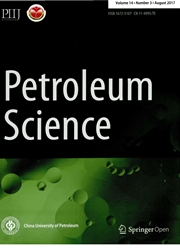

 中文摘要:
中文摘要:
依据岩心观测以及岩石力学性质试验发现,研究地区致密薄互层油藏具有岩性、力学性质变化频次高,变化范围尺度小的特点。结合现场压裂数据,推断薄互层油藏压裂后产能低的主要原因是:压裂过程中,由于弱胶结面的存在,水力裂缝在层间的多次错动,导致水力裂缝缝高扩展受到抑制;压裂结束后,由于地应力作用,层间错动面闭合,有效水力裂缝面积减小。针对该推断,制备薄互层物理模拟试样,进行压裂物理模拟试验。通过物理模拟试验结果发现:层间高弹性模量差异,对于水力裂缝垂向扩展的抑制作用并不明显。在破裂压力后,增加排量仅对增大水力裂缝的体积有促进作用,对水力裂缝穿入其他岩层的作用较小或是没有。
 英文摘要:
英文摘要:
According to the observation of the core samples and the rock mechanical properties tests in the tight thin interbedded reservoirs in research area,the characteristics of the reservoirs have been discovered.The reservoirs have the high frequency change rate of rock lithology and mechanical properties,and its variation range is small scale.With the analysis of the field hydraulic operation curves,the reasons for the low productivity of these reservoirs can infer as follow.During the fracturing,the offsets occur in the layers due to the weak interface making the restraint of the fracture height propagation.After the treatment of the hydraulic fracturing,the offsets are gradually closed due to the in-situ stress leading the effective fracture area reduced.In order to prove this inference,the physical simulation specimens are prepared to simulate the thin interbedded reservoirs.The experimental results show as follous.(1) The high modulus difference between layers has limited effect on the restraint of the fracture height propagation.(2) After the break pressure,it is significant to expand the fracture volume by increasing the injection rate.But it has little or no effect on the penetration of hydraulic fractures into other layers.
 同期刊论文项目
同期刊论文项目
 同项目期刊论文
同项目期刊论文
 Experimental study and numerical modeling of brittle fracture of carbonate rock under uniaxial compr
Experimental study and numerical modeling of brittle fracture of carbonate rock under uniaxial compr Oil Removing Technology of Residues from Waste Oil-based Drilling Fluid Treated by Solid-liquid Sepa
Oil Removing Technology of Residues from Waste Oil-based Drilling Fluid Treated by Solid-liquid Sepa 期刊信息
期刊信息
